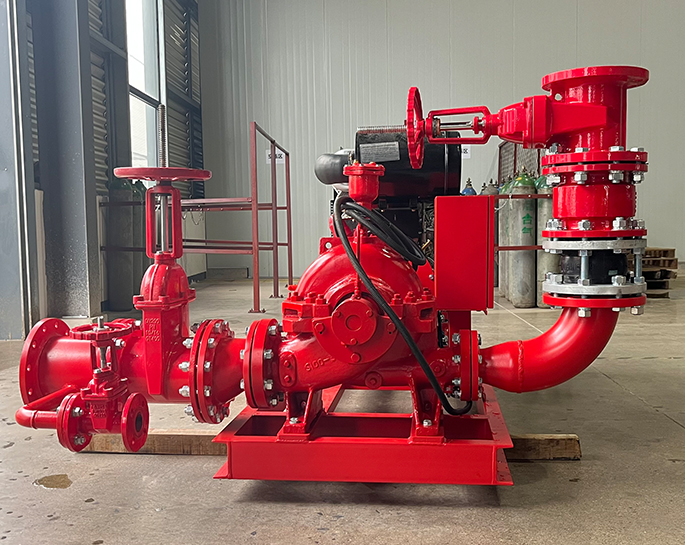What should I do if the electric fire pump does not start?
May 21, 2024
Share:
If the electric fire pump does not start, it is crucial to act swiftly to identify and rectify the issue to ensure fire protection systems are operational. Here's a step-by-step guide to troubleshooting:
### Immediate Steps
1. **Check the Power Supply:**
- **Verify Power:** Ensure the pump has power. Check if the main power supply and the control panel are on.
- **Circuit Breakers:** Inspect the circuit breakers and fuses. Reset any tripped breakers or replace blown fuses.
- **Voltage Levels:** Measure the voltage at the pump controller to ensure it is within acceptable limits.
2. **Inspect the Control Panel:**
- **Status Indicators:** Look at the control panel for any fault indicators or alarms that can provide clues (e.g., phase failure, low voltage, overload).
- **Manual Start:** Try to start the pump manually from the control panel.
3. **Examine the Start/Stop Control:**
- **Remote Start/Stop:** Ensure there are no issues with remote start/stop controls, such as emergency stop buttons being engaged.
- **Wiring:** Check for loose or damaged wiring connections in the control circuits.
### Detailed Troubleshooting
4. **Motor and Pump Inspection:**
- **Motor Condition:** Inspect the motor for signs of overheating or unusual noises. Test motor windings with a multimeter for continuity and insulation resistance.
- **Pump Mechanics:** Ensure the pump is not mechanically bound or obstructed. Check for leaks or damage in the pump casing and impeller.
5. **System Pressure and Flow:**
- **Pressure Switch:** Verify the settings and functionality of pressure switches. Ensure they are not set too high or too low.
- **Flow Meters:** Check that flow meters and pressure gauges are operational and providing accurate readings.
### Advanced Checks
6. **Controllers and Relays:**
- **Controller Settings:** Ensure the fire pump controller settings are correct according to the manufacturer’s specifications.
- **Relays and Contactors:** Inspect and test relays and contactors for functionality. Replace any that are defective.
7. **Automatic Transfer Switch (ATS):**
- **Generator Backup:** If the pump is connected to a generator, ensure the automatic transfer switch (ATS) is functioning correctly and the generator is operational.
### Maintenance Records and Support
8. **Review Maintenance Logs:**
- **Previous Issues:** Check maintenance records for recurring issues that might provide insight into the current problem.
- **Service History:** Ensure that regular maintenance has been performed according to the manufacturer’s guidelines.
9. **Consult Professionals:**
- **Technician Support:** If the problem persists after basic troubleshooting, contact a qualified fire pump technician or the manufacturer’s support service for advanced diagnostics and repairs.
### Preventive Measures
- **Regular Testing:** Perform regular operational tests to ensure the fire pump is ready in case of an emergency.
- **Routine Maintenance:** Follow a strict maintenance schedule to prevent issues and ensure all components are in working order.
By systematically checking each potential issue, you can identify the cause of the fire pump failure and take appropriate corrective actions. Regular maintenance and testing are essential to prevent such failures and ensure the fire safety system remains fully functional.

### Immediate Steps
1. **Check the Power Supply:**
- **Verify Power:** Ensure the pump has power. Check if the main power supply and the control panel are on.
- **Circuit Breakers:** Inspect the circuit breakers and fuses. Reset any tripped breakers or replace blown fuses.
- **Voltage Levels:** Measure the voltage at the pump controller to ensure it is within acceptable limits.
2. **Inspect the Control Panel:**
- **Status Indicators:** Look at the control panel for any fault indicators or alarms that can provide clues (e.g., phase failure, low voltage, overload).
- **Manual Start:** Try to start the pump manually from the control panel.
3. **Examine the Start/Stop Control:**
- **Remote Start/Stop:** Ensure there are no issues with remote start/stop controls, such as emergency stop buttons being engaged.
- **Wiring:** Check for loose or damaged wiring connections in the control circuits.
### Detailed Troubleshooting
4. **Motor and Pump Inspection:**
- **Motor Condition:** Inspect the motor for signs of overheating or unusual noises. Test motor windings with a multimeter for continuity and insulation resistance.
- **Pump Mechanics:** Ensure the pump is not mechanically bound or obstructed. Check for leaks or damage in the pump casing and impeller.
5. **System Pressure and Flow:**
- **Pressure Switch:** Verify the settings and functionality of pressure switches. Ensure they are not set too high or too low.
- **Flow Meters:** Check that flow meters and pressure gauges are operational and providing accurate readings.
### Advanced Checks
6. **Controllers and Relays:**
- **Controller Settings:** Ensure the fire pump controller settings are correct according to the manufacturer’s specifications.
- **Relays and Contactors:** Inspect and test relays and contactors for functionality. Replace any that are defective.
7. **Automatic Transfer Switch (ATS):**
- **Generator Backup:** If the pump is connected to a generator, ensure the automatic transfer switch (ATS) is functioning correctly and the generator is operational.
### Maintenance Records and Support
8. **Review Maintenance Logs:**
- **Previous Issues:** Check maintenance records for recurring issues that might provide insight into the current problem.
- **Service History:** Ensure that regular maintenance has been performed according to the manufacturer’s guidelines.
9. **Consult Professionals:**
- **Technician Support:** If the problem persists after basic troubleshooting, contact a qualified fire pump technician or the manufacturer’s support service for advanced diagnostics and repairs.
### Preventive Measures
- **Regular Testing:** Perform regular operational tests to ensure the fire pump is ready in case of an emergency.
- **Routine Maintenance:** Follow a strict maintenance schedule to prevent issues and ensure all components are in working order.
By systematically checking each potential issue, you can identify the cause of the fire pump failure and take appropriate corrective actions. Regular maintenance and testing are essential to prevent such failures and ensure the fire safety system remains fully functional.


.png)
.png)

.png)


